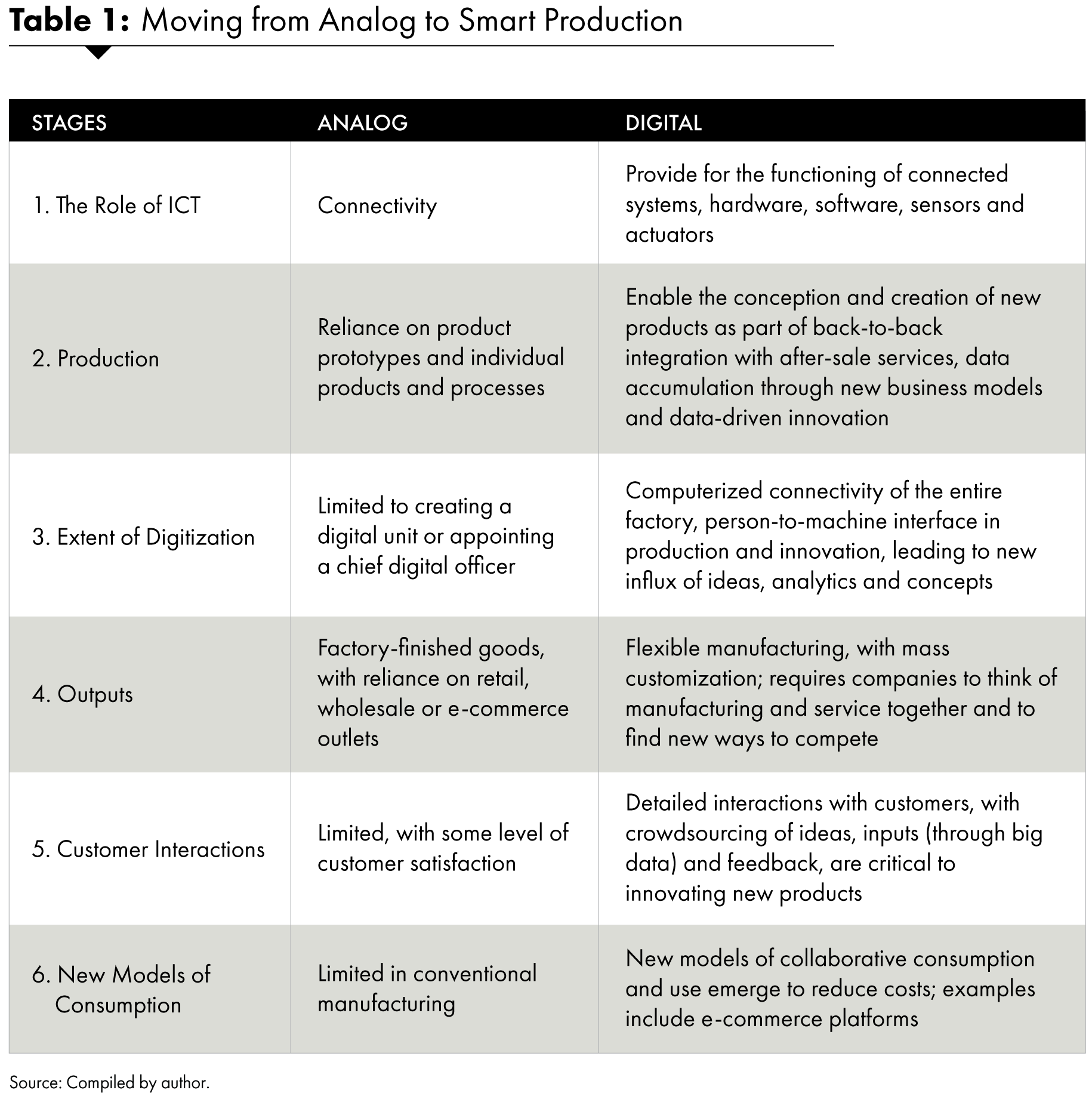Despite the rise of market-dominating digital technology companies, many entrepreneurial firms in developing countries have made large strides in creating their own product markets. For example, mPedigree, a Ghanaian company, has created a unique product identification marker as an anti-counterfeit solution for pharmaceuticals in the African market. And M-KOPA Solar, a Kenyan company, is enabling decentralized solar power solutions with a pay-as-you-go model. These firms’ ability to promote economically and socially empowering change, and to cater to underserved markets profitably, raises an intriguing question: can developing countries host homegrown, data-driven innovation on a large scale?
This question has no easy answer. Enabling data-driven innovation of this kind on a systemic scale remains a black box for many countries that have previously tried and failed to promote technological change, innovation capacity and economic development. Developing countries have sought to look at other countries — industrialized, as well as emerging economies — to understand how to move economies from traditional production (such as agriculture) to modern sectors, and how to promote innovation, which is central to that process.
On the basis of the successes of East Asian economies, policy changes of this kind have focused on introducing more stringent industrial strategies that promote foreign direct investment and induce technology transfer. But more recently, accounts suggest that these policy lessons do not always apply in new environments, not only because incentives fail to spur similar results in two different countries, but also because incentives are often not well linked to local realities and enterprise-level activities. New research also suggests that not all industrial policies are the same. While they can be welfare-enhancing in some cases, they can also be welfare-reducing in others. These are essential facts to bear in mind in the digital era, where capitalizing on opportunities is less about learning from what happened in another country (in a different time and context) and more about determining which policy could help local firms to innovate, given their particular strengths and challenges.
Identifying the Innovation Opportunity
Firms in less-developed economic contexts are undermined by distinct shortcomings that are deeply embedded in the institutional and industrial climate. Investment in research and development has been low for decades, public science institutions routinely underperform, relevant human resources are scarce, entrepreneurial spirit is subdued and a number of extension mechanisms that are critical for industry survival (finance, management, marketing and technology incubation, for example) are weak or not well-coordinated. Addressing all of these shortcomings simultaneously is nearly impossible. Instead, firms and regulators alike must identify the innovation opportunity and prioritize enabling growth in that area.
Data-driven innovation primarily falls into two categories: value capture and value creation. On the one hand, value-capturing innovation does not depend on the creation of new knowledge per se; it relies on new business models that create new markets. Commonly witnessed among platforms, this kind of innovation allows firms to introduce products more efficiently by connecting supply with demand in uncaptured or underserved markets. While local firms may find it easier to engage in this type of innovation, successful value capture requires policy makers to level the playing field so that local firms can compete with established firms in the platform economy. Data protection and privacy laws are relevant here, but it is just as important to consider regulations on digital infrastructure, competition policy (to guard against unfair data harvesting) and incentives that promote a greater symbiosis of research, entrepreneurship, information and communications technology (ICT) and new digital technologies.
Value-creating innovation on the other hand, is far more complex, and characterized by a few key traits. First, it builds on existing advantages in manufacturing and services to incorporate data and create entirely new technologies (for example, the smart car falls into this category). Second, in value-creating innovation, data serves as both an input and an output for innovation; a number of digital technologies co-exist and interact to create new products and processes. For example, artificial intelligence (AI), big data and cyber-physical systems all work together to benefit from the data generated by the use of smart cars to inform new technological breakthroughs and social efficiency gains (such as improved traffic control or city management). Relying in equal parts on data access and digital infrastructure, value-creating innovation calls for strengthening and building skills and capabilities (in particular, institutional ones) to promote productivity in all sectors of the economy.
Enabling Local Firms to Innovate
Policy making in the digital era, therefore, must be deeply engaged in envisioning and promoting the ways in which digital technologies can help improve the performance of local firms in developing countries. Several studies have correctly identified the building of capabilities to be a fundamental challenge in linking structural change to institutions and long-run performance. Stuck in cycles of depressed consumer demand, low growth, low technology and poor physical infrastructure, firms in developing countries need technological capabilities that help them move from analog to digital production to engage in value-capturing innovation and to scale in manufacturing sectors. But firms also need management capabilities to see and take stock of what they do not know. The secret is not in what they were producing before but in how prepared they are to identify and build on these new technologies. Management and enterprise capabilities and risk taking at local firms must be nurtured. Other forms of capabilities, as illustrated in Table 1, are also required to facilitate the move from analog to digital production.

The good news for policy making is that this process of capabilities can be self-reinforcing. Even at the simplest level, big data trends allow firms to better understand their customers and their preferences, and to expand markets. Firms, therefore, can create value by incrementally changing their product design or service portfolios to suit consumer needs, or even by focusing on reducing labour costs by reorganizing the work force, thereby increasing productivity gains. Integrating digitization can also enable local firms to move to data-driven value chains. When firms are able to develop their own “smart” products in some areas of manufacturing, they can also progress to collect data at each stage of use by their consumers, thereby enhancing their own data pools. These data pools can be used to feed into data analytics to train AI systems that are also useful to local contexts.
The Relevance of Innovation Governance
Unfortunately, developing country ambitions to become innovation players will not be realized without an emphasis on innovation governance, which remains critically under-addressed until now. The debate on national digital strategies is only beginning and does not often focus on supporting local firms. Connecting the two is essential for successful digital transformation.
Several issues of innovation governance will emerge. First of these is the lack of statistical data collection capacity in the developing world for all sectors (not just manufacturing), which often makes it difficult to measure innovation, take stock systematically and intervene. Second, there is a critical neglect of standards, which are essential to elaborate on the roles and obligations of all actors in data value chains and can also lay out data collection, access and sharing rules. To enable firms’ access to data while protecting private users, policies should focus on data privacy, and at the same time, promote data use through instruments such as data cooperatives, data trusts or global data pools. Lastly, new policies must support the emergence of new, alternative technology architectures that not only preserve local values, but also provide digital infrastructure that enables local firms to emerge from backlot production units to more sophisticated industrial outfits.
If conceived and implemented well, such policies afford an incredible opportunity for developing countries to reconceptualize manufacturing as a smaller, more technologically intensive activity, with specific contributions to the supply chains globally. On the services front, such policies can enable firms to engage in several kinds of value-capture innovations and promote local services. Incentives for market-creating innovations — those that create new markets, enable supply and demand linkages and promote employment — should be a priority. If such outcomes are enabled, then by better linking innovation with tax policies, infrastructure projects and urban development, developing countries can truly harness digital change and the social empowerment that comes with it.



